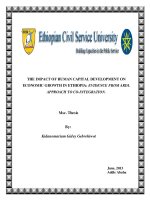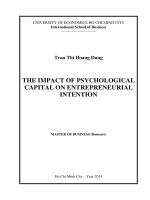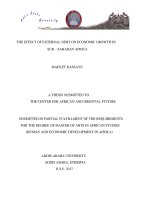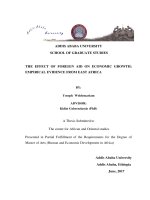the impact of human capital on economic growth. a case study in post-soviet ukraine, 1989 - 2009
Bạn đang xem bản rút gọn của tài liệu. Xem và tải ngay bản đầy đủ của tài liệu tại đây (2 MB, 228 trang )
THE IMPACT OF HUMAN
CAPITAL ON ECONOMIC
GROWTH
This page intentionally left blank
THE IMPACT OF HUMAN
CAPITAL ON ECONOMIC
GROWTH
A Case Study in Post-Soviet Ukraine,
1989–2009
Ararat L. Osipian
THE IMPACT OF HUMAN CAPITAL ON ECONOMIC GROWTH
Copyright © Ararat L. Osipian, 2009.
All rights reserved.
First published in 2009 by
PALGRAVE MACMILLAN®
in the United States—a division of St. Martin’s Press LLC,
175 Fifth Avenue, New York, NY 10010.
Where this book is distributed in the UK, Europe and the rest of the world,
this is by Palgrave Macmillan, a division of Macmillan Publishers Limited,
registered in England, company number 785998, of Houndmills,
Basingstoke, Hampshire RG21 6XS.
Palgrave Macmillan is the global academic imprint of the above companies
and has companies and representatives throughout the world.
Palgrave® and Macmillan® are registered trademarks in the United States,
the United Kingdom, Europe and other countries.
ISBN: 978–0–230–61824–4
Library of Congress Cataloging-in-Publication Data
Osipian, Ararat L.
The impact of human capital on economic growth : a case study in
post-Soviet Ukraine, 1989–2009 / Ararat L. Osipian.
p. cm.
Includes bibliographical references and index.
ISBN 978–0–230–61824–4
1. Human capital—Ukraine. 2. Economic development—Ukraine.
3. Ukraine—Economic policy—1991– I. Title.
HD4904.7.O85 2009
338.9477—dc22 2009002877
A catalogue record of the book is available from the British Library.
Design by Newgen Imaging Systems (P) Ltd., Chennai, India.
First edition: September 2009
10 9 8 7 6 5 4 3 2 1
Printed in the United States of America.
CONTENTS
List of Figures ix
List of Tables xi
Foreword xiii
Preface xv
Introduction xvii
Part I Genesis of the Growth Theories 1
1.1 Early Concepts of Growth 1
1.2 Classics of Economic Growth 3
1.3 Schumpeter’s Creative Destruction and Beyond 4
1.4 Modern Theories of Growth 6
1.5 Solow Model of Exogenous Growth 12
1.6 Leontief’s Poverty Trap 17
1.7 Growth Reconsidered: Endogeneity of Human Capital 23
1.8 Institutions and Growth 27
1.9 Dependency Theory and Structuralists 31
1.10 Economic Development-Growth-Transition Triangle 33
1.11 Growth Theory in the Post-Soviet Ukraine 39
1.11.1 Inferences for the Post-Soviet Ukraine 39
1.11.2 Economic Growth in the Works of
Ukrainian and Russian Economists 46
1.12 Concluding Remarks 48
Part II Endogenous Economic Growth in Ukraine 51
2.1 Possibility of Endogenous Growth in Ukraine 51
2.2 Place of Growth in the Transition
Economy of Ukraine 60
vi
CONTENTS
2.3 Growth Forecasts and their Explanation 68
2.4 Transition from Exogenous to Endogenous
Economic Growth 75
2.5 Education Corruption, Reform, and Growth 87
2.5.1 Basis for Corruption 87
2.5.2 Education Corruption 90
2.5.3 Education Corruption in Ukraine 93
2.5.4 Impact of Education Corruption on Growth 99
2.6 Concluding Remarks 106
Part III Economic Growth in
Ukraine and other NIS 107
3.1 Recession: Myth and Reality 108
3.1.1 Cumulative Output Decline and
Period of Recovery 108
3.1.2 Corruption and its Impact on
Economic Growth 111
3.1.3 Shadow Sector, Unofficial
Economy, and its Size 113
3.1.4 Energy Production and Consumption 117
3.2 Macroeconomic Indicators in Ukraine 119
3.2.1 Structure of GDP Growth by
Expenditures in Ukraine 119
3.2.2 Volume of Direct and Portfolio
Investments in Ukraine 120
3.2.3 Capital Flight, Foreign Debt, and
Debt Service in Ukraine 122
3.2.4 Unemployment and the Labor Market in
Ukraine and other NIS 124
3.3 Macroeconomic and Social Indicators of
the Former Soviet Bloc 127
3.3.1 Population Income in Ukraine 127
3.3.2 Dynamics of Personal Income and
Consumer Price Index in Ukraine 129
3.3.3 Labor Productivity and Wages in Ukraine 133
3.4 Human Capital 134
3.4.1 Access to Education, Health Care, and Housing 135
3.4.2 Life Expectancy 142
3.4.3 Socioeconomic Progress: Openness and Well-Being 143
3.4.4 R&D in Ukraine 145
3.5 Concluding Remarks 147
vii
CONTENTS
Part IV Empirical Study 149
4.1 The Endogenous Model of Economic Growth 149
4.2 Calculations without the Time Lag 151
4.2.1 The Data 151
4.2.2 Empirical Results 152
4.3 Calculations with the Time Lag 155
4.3.1 The Data 155
4.3.2 Empirical Results 157
4.4 Concluding Remarks 166
4.5 Conclusions and Policy Recommendations 168
Appendices 173
Appendix I 173
Appendix II 175
References 177
Index 205
This page intentionally left blank
FIGURES
1.1 Leontief ’s poverty trap 19
1.2 Poverty trap according to the modern
interpretation by Barro and Sala-i-Martin (1999) 22
2.1 Potential for exogenous growth in factors of
production: labor 83
2.2 Potential for exogenous growth in factors of
production: capital 84
3.1 Correlation of cumulative output decline and
total number of consecutive years of output decline
in the NIS, 1990–1999 110
3.2 Correlation of cumulative output decline and total number
of consecutive years of output decline in the Central and
Eastern Europe and the Baltic states, 1990–1999 111
3.3 Correlation of the GDP per capita growth and estimates
of corruption made by the businessmen in the NIS and
CEE countries of the former Socialist Bloc, 2002 113
3.4 Unofficial GDP in the Eastern European
countries, 1989–1995 115
3.5 Unofficial GDP in the former USSR, 1989–1995 116
3.6 Contribution of private consumption, government
consumption, gross fixed investment, and stock-building
to real GDP in Ukraine (in %), 1993–2010 120
3.7 Number of students in higher education institutions
per 10,000 population in NIS, 1980–1999 137
4.1 Real GDP per capita growth in Hungary,
Poland, the Russian Federation, and Ukraine
(with the log trajectories), 1989–2010 155
4.2 Investment in constant capital in Hungary,
Poland, the Russian Federation, and Ukraine
(with the log trajectories), 1989–2010 156
x
FIGURES
4.3 Savings rate in Hungary, Poland, the Russian Federation,
and Ukraine (with the log trajectories), 1989–2010 156
4.4 Registered level of unemployment in Hungary,
Poland, the Russian Federation, and Ukraine
(with the log trajectories), 1989–2010 157
TABLES
2.1 Origins of GDP and structure of employment in
selected countries, 2004 78
2.2 Potential for exogenous growth by factor of production 83
2.3 Everyday corruption market characteristics in
the Russian education sector, 2001 and 2005 98
3.1 Business-related corruption (% of managers surveyed
ranking this as a major business constraint) in
NIS and CEE, 2002 112
3.2 Unofficial GDP in the former USSR and
the Eastern European countries, 1989–1995 114
3.3 Share of the unofficial DGP in the total GDP (%)
in selected countries, 1990 117
3.4 Economically active population in the Commonwealth of
Independent States (CIS; in thousands), 1990–1999 126
3.5 Personal disposable income in Ukraine
(in billion $), 1993–2010 128
3.6 Productivity in Ukraine, including labor
productivity and labor costs, 1992–2010 134
3.7 Number of students in higher education institutions
per 10,000 population in NIS, 1980–1999 136
3.8 Number of physicians per 10,000 population in
the CIS, 1980–1999 139
3.9 Average total housing space per inhabitant in
the CIS (in square meters), 1990–1999 141
3.10 R&D employment structure in Ukraine, 1989–1999 146
4.1 Regression results for Hungary, Poland, and
the Russian Federation 153
4.2 Regression results of GDP growth to investment,
savings, and unemployment for Hungary, Poland,
the Russian Federation, and Ukraine, 1990–2010 158
xii
TABLES
4.3 Regression results of GDP growth to investment,
savings, and unemployment for Hungary, Poland,
the Russian Federation and Ukraine, 1990–2010
with the constant coefficient 160
4.4 Regression results of GDP growth to investment,
savings, unemployment, education, and health care for
the Russian Federation and Ukraine, 1990–2010 161
4.5 Regression results of GDP growth to investment,
savings, education, and health care for the Russian
Federation and Ukraine, 1990–2010 162
4.6 Regression results of GDP growth to investment,
savings, education, and health care for the Russian
Federation and Ukraine, 1990–2010 163
4.7 Regression results of GDP growth to investment,
savings, and education for the Russian Federation and
Ukraine, 1990–2010 164
4.8 Regression results of GDP growth to investment,
savings, and education for the Russian Federation and
Ukraine, 1990–2010 165
4.9 Regression results of GDP growth to investment,
savings, and education for the Russian Federation and
Ukraine, 1990–2010 166
A.1 GDP per capita growth in the NIS and CEE countries,
1989–2004 (annual % change) 173
A.2 Selected indicators of GDP in Ukraine, 1989–2010 175
FOREWORD
T
he ideas of public spending and foreign investment as major engines
of economic growth, especially in developing nations, are now
replaced with ideas about the importance of reinvestment and develop-
ment of domestic market. The theories of growth based on the fundamen-
tal assumption that a significant inf lux of the resources is necessary to
initiate sustainable growth do not hold. They might work to a certain
degree in the developing world, but appear to be insufficient to explain
rapid economic growth in Ukraine and other industrialized nations of the
former Soviet Bloc. Theories of import substitution now compete with
post-structuralism. In education, long dominated concept of manpower
forecasting gives way to market reforms. These two trends—structural
reforms with domestic market development and market reforms in the
education sector—define the future landscape of transition economies.
The goal of this book is to identify the place and the role of human
capital in economic growth in the market-type post-transition econo-
mies. It fills the gap between the rapid economic growth as an objective
economic reality of Ukraine and Russia and the lack of scholarly litera-
ture on the issue. This book focuses on the role of human capital as a
necessary ground for initiation of economic growth in transition econo-
mies. In our view, the choice of both the object of the research and the
time frame is very successful and well-justified. In the future, one would
like to see further development of the research on sustainable economic
growth in those economic systems that are currently not in equilibrium
and only move toward their steady state.
Among the many merits of this book, we would like to highlight the
following. The literature review unites in itself the chronology of changes
in the theory of economic growth and the analysis of major problems of
growth. Such a synthesis appears to be especially appealing, since it allows
the following of the process of development of different models of growth
that leads to qualitative changes and competition between exogenous and
xiv
FOREWORD
endogenous theories of growth. In the literature review, the author con-
centrates on the discussion of major ideas of economic growth, expressed
by the leading economists in this field. This approach advances the spirit
of discussion and debate. In the empirical part of the book, the author
concludes that in the countries with high levels of human capital, includ-
ing educational level of population, it is very difficult to purify the posi-
tive effect of education on economic growth. We agree with the author
that the next advancement in the pace of economic growth in the transi-
tion economies will become possible only based on the process of reno-
vation and long-term investment into principal capital. This is necessitated
by the high degree of depreciation of machinery and production facilities
in Ukraine and other transition economies and by the outdated technol-
ogies of production. The process of renovation itself will result in the
continuation of strong economic growth. However, such a renovation is
only possible based on significant investments. An increase in the quality
of products and productivity overall appears to be impossible even with
the relatively high quality of labor force simply because of the physically
deteriorated and morally outdated equipment and technologies. After the
renovation, the economy will continue to grow on the basis of new pro-
duction capacities, technological advancements, and further accumula-
tion of human capital needed to use new equipment and technologies.
From this perspective, the author suggests further institutional and struc-
tural changes in Ukraine.
V S
Deputy Director and Professor
Institute for the USA and Canadian Studies
Russian Academy of Sciences
PREFACE
U
kraine has a strategic location between Europe and Asia and remains
geopolitically indecisive and squeezed between the West and
Russia. This geopolitical position predetermines high interest to the
country. Surprisingly, little has been said about this nation since it gained
independence after the disintegration of the Soviet Union in 1991. Recent
political events that have become known as the Orange Revolution
attracted the world’s interest to the country, but changed little in the lives
of Ukrainians. Strategic developments in the region, including interests
of the European Union, NATO, and Russia, warrant more focus on
Ukraine in the near future. More attention to the country’s development
may be expected over the next few decades. Despite the fact that Ukraine
is an industrialized nation of 50 million people and the largest country in
Europe, little is known about its economy. Economic life in Ukraine
remains terra incognita, indeed. Inferences are often drawn on Ukraine
from the research done on Russia. Such inferences, however, are not
always precise or appropriate. The developments in the nation’s economic
thought and the description of the processes in the national economy
appear to be the reverse of the economic ideas that have been developed
in evolutionary Western economics. First, there were formal models of
growth in the Western economic thought that were then extended and
applied to the issues of economic development, institutional change,
structuralism, and other issues concerned with the Third World coun-
tries. In Ukraine, along with other former Soviet republics, a lot is being
said about institutional changes, market reforms, and socioeconomic
transition, but little to nothing is produced in the tradition of hard core
economics, including models of growth. Over the last eight years,
Ukraine demonstrated a rapid economic growth. This growth was pre-
ceded by the sharp decline in the national production, linked to the
exhausting and ill-planned transition from the planned economy to the
market economy. Some analytical scholarly work on transition economics
xvi
PREFACE
is available along with reports by the IMF and the World Bank, but no
rigorous empirical work on economic growth can be found. Deeper
investigation of potential sources of economic growth in Ukraine is
needed. The causes of growth remain unclear, while the growth itself
appears to be sustainable, not accidental. This contradicts predictions of
poverty trap theories and points to the leading role of internal resources.
In this research, preference is given to the endogenous model of eco-
nomic growth. As a result of the review of a broad spectrum of literature
in historical perspective, it has been found that the exogenous models of
Solow-Swan and Leontief do not offer complete and adequate reflection
of the transition experience. The purpose of this study is to provide a sys-
tematic investigation of the human capital-economic growth nexus. The
impact of human capital on economic growth is incorporated within
the context of economic transition. Such a contextualization places the
research of growth in an appropriate framework, keeping it connected to
other aspects of economic transition. The endogenous growth model is
used as it is most appropriate for evaluation. This model is developed for
cross-sectional analysis and shows the influence and importance of human
capital for economic growth relative to other key inputs and to differ-
ences across countries. A variety of measures of human capital frequently
used in applied growth studies is employed. We also estimate a system of
linear equations. While intuition and theories of endogenous growth
would point toward a positive effect of human capital on economic
growth, empirical evidence on this issue is mixed. In our view, the next
economic advancement in Ukraine will become possible based on the
process of renovation and investment into principal capital. Further insti-
tutional and structural changes in the economy are needed. It will increase
domestic and foreign investment, further develop domestic market, and
sustain already achieved substantial GDP per capita growth.
INTRODUCTION
E
conomic growth is one of the fundamental issues in economics. The
issue of economic growth has been one of the key issues of economic
theory and macroeconomics for a long time, tied to the issues of general
equilibrium and economic cycles. The process of growth is traditionally
considered as a quintessence of an increased scale reproduction, socioeco-
nomic development, and social progress. Sustainable economic growth
within the limits of national systems and regional enclaves is a guarantor
of sustainable development.
The ideas of public spending and foreign investment as major engines
of economic growth, especially in developing nations, are now replaced
with ideas about the importance of reinvestment and development of
domestic market. The theories of growth based on the fundamental
assumption that a significant influx of the resources is necessary to ini-
tiate sustainable growth do not hold. They might work to a certain degree
in the developing world, but appear to be insufficient to explain rapid
economic growth in Ukraine.
The socioeconomic transition in Ukraine may be considered as suc-
cessful. Political and economic reforms lead to the creation of a predom-
inantly market economy. By 2004 Ukraine achieved pre-transition level
of GDP per capita. The positive economic growth took place since 1999.
At the same time, the theme of economic growth did not receive much
attention in the scholarly literature in the region. Ukrainian and Russian
economists have only produced a very insignificant number of works on
this issue. As a result, scholarly publications lag behind the economic
realities, at best explaining them, but not analyzing them well enough
and not presenting well-grounded forecasts. This may be explained, in
part, by the low level of familiarity of the Soviet and post-Soviet econo-
mists with the Western literature on economic growth, major concepts
and theories of growth, macroeconomics, and analytical techniques,
including statistical and econometric analysis.
xviii
INTRODUCTION
Works on the issues and different aspects of economic growth in tran-
sition and post-transition economies are presented by such Ukrainian
economists as Aleksandrova (2003a and b), Bazhal and Odotjuk (2003),
Bolhovitinova (2003), Borejko (2005), Chuhno (1996), Danilishin and
Kucenko (2006), Dem’janenko (2003a and b), Gal’chin’kij (2004), Heyets
(1999, 2000, 2001, 2003), Hrytsenko (1997, 2003), Kendjuhov (2005),
Krjuchkova (2000), Kvasnjuk (2000, 2003a and b), Gal’chinskij and
Levochkin (2004), Novitskij (2005), Olijnik (2003), Petkova (2005),
Pokrytan (1997), Prihod’ko (2003a–f), Shchedrina (2003), Shubravskaja
(2005), Sidenko (2003a and b), Suhorukov (2006), Tarasevich et al.
(2003), Tochilin (2001), Vahnenko (2000, 2003), Vovkanich (2005),
Vozhzhov (2004), Yaremenko (2003), and Yatskevich (2006).
Certain contribution to the research of economic growth in
transition and post-transition economies was made by Russian
economists Balabanova (2004), Bessonov (2005), Chechelev et al. (2001),
Cherednichenko (2004), Dubjanskaja (2005), Evstigneeva and Evstigneev
(2005), Fridman et al. (1998), Garipova et al. (2005), Golub (2006),
Grushevskaja (2004), Hristenko et al. (2002), Ivanter (2004, 2006), Ivlev
(2004), Kalinina (2005), Kosenkov (2005), Koshkin and Shabaev (2004),
Kuznetsova (2000), Kvashnina (2004), L’vov (2004), Lashov and
Spizharskaja (2004), Ovchinnikova (2004), Pavlova (2001), Perepelkin
(2001), Perminov et al. (2004), Ponomarev (2004), Romanova (2002),
Saktoev (1999), Salijchuk (2004), Savchenko (2005), Seleznev (2001),
Simkina (2002), Sokolovskij (2001), Solovejkina (2002), Spirjagin (2005),
Tjurina (2005), Tolmachev (2005), Ungaeva (2005), Veretennikova
(2005), Vilenskij et al. (2002), Zas’ko (2004), Zemskova (2005), Zhits
(2000), and Zverev (2005).
The major problem with the existing research is that it is fragmented,
mostly limited to small journal articles, book chapters, and few disserta-
tions. No complex studies of economic growth have been presented by
the local scholars. As a result, there is a widening gap in the scholarly lit-
erature on economic growth in Ukraine. The goal of this work is to fill
the gap between the rapid economic growth as an objective economic
reality of Ukraine and the lack of scholarly literature on the issue. This
book presents a theoretical and empirical investigation of economic
growth and the possible impact of human capital on economic growth in
transition economies of Ukraine. For comparison, it analyses similar
processes in Russia, Poland, and Hungary as well as in some other coun-
tries in the region during the period of 1989–2009. It defines place and
role of human capital in the process of transition from the exogenous
to the endogenous forms of growth and socioeconomic development.
xix
INTRODUCTION
A substantial part of the book is devoted to the integrative scholarly syn-
thesis of the Western literature on economic growth with special empha-
sis on theoretical aspects of growth. We consider economic transition
within the set of theories of economic growth and at the same time con-
sider the phenomenon of economic growth in the context of post-Soviet
transition. Such a contextualization allows for finding and highlighting
certain features and processes within economic transition that were ear-
lier neglected by the scholars.
Part I contains an integrative literature synthesis of the major contri-
butions to the theory of economic growth. It presents both exogenous
and endogenous theories of economic growth. In this part, we argue that
exogenous economic growth models of Solow-Swan and Leontief do not
offer an adequate description of the transition experience. Part II presents
an analysis of the process of transition and points to the exogenous and
endogenous components of current economic growth in Ukraine. This
part argues for the need to move from predominantly exogenous to
endogenous type of growth. Part III is focused on the data analysis. It
presents a substantial bloc of data on Ukraine. Among the models of eco-
nomic growth, presented in the literature, endogenous model is chosen as
most appropriate for our evaluation. Part IV presents description of the
model, the data, and empirical results. It also presents the results of esti-
mating a set of equations and impulse response function. Conclusions and
policy recommendations are presented in the Conclusion.
This page intentionally left blank
PART I
GENESIS OF THE GROWTH
THEORIES
W
e will start from the review of major developments of economic
thought over the last few centuries as related to economic growth.
This review is a combination of chronological changes and focuses on
particular issues in theories of growth. In this manner, we offer an inte-
grative scholarly synthesis of economic growth. This synthesis allows
demonstrating incremental development of the models turned into qual-
itative transitions and rivalry of exogenous and endogenous concepts of
growth. The review is built around the ideas that the economists formu-
late rather than around the economists themselves. It draws some prelim-
inary inferences for Ukraine. This is done in order to show the high
degree of applicability of earlier and modern theories of economic growth
to contemporary Ukraine. The explanatory power of early and modern
concepts of growth is such that it can be of use in understanding the pro-
cesses of economic transition in Ukraine and first of all, growth. It is not
overloaded with the complex mathematical equations and keeps the major
ideas and critiques easily understandable for the reader while placing the
topic in the broader scholarly literature. Deeper understanding of eco-
nomic growth requires evaluating the theory of growth in an historical
perspective.
1.1 Early Concepts of Growth
Later mercantilists may be considered as founding fathers of the modern
theories of growth. At the early stages of development of growth theory
economists considered growth as a process of an increase in the national
wealth. Theories of economic growth acquired a major direction during
2
IMPACT OF HUMAN CAPITAL ON ECONOMIC GROWTH
the time of mercantilists’ domination in the fifteenth–seventeenth
centuries and Physiocrats of the eighteenth century (Kregel, 1973).
Mercantilists considered accumulation of wealth as the major source of
economic growth and the major goal of economic activities of mer-
chants and the state (McDermott, 1999). Representatives of the early
mercantilism gave their preference to precious metals and metallic
money as materials with perfect liquidity. The late mercantilists consid-
ered economic wealth of a nation in terms of total volume of produced
commodities and supported positive trade balance. This tendency can
partially be explained by the development of manufacturing and
domestic markets. According to mercantilists, opportunities of obtain-
ing profit from commodity production and access to credit resources
facilitate multiplication of wealth. Presence of sufficient amount of
metal money, that is, golden and silver coins, gives necessary access to
credit and relatively low affordable borrowing interest rate in the coun-
try. For this reason mercantilists insisted on limiting gold outf low from
the country.
Presence of golden and silver coins in monetary circulation was given
a status of the necessary ground for economic growth. The active trade
and commerce was considered as a precondition for economic growth.
This approach can be considered as historically justified. All the capital in
that era was represented by the trade capital, while there was no manufactur-
ing capital in substantial quantity. Mercantilists favored export since it was
a primary source of metal money and at the same time supported restric-
tions on import of goods in the country. Such a policy was intended to
maintain positive trade balance, sufficient amount of money, and hence
stable economic growth. Mercantilists voted for the low wages and thought
that high wages will lead to a decrease in productivity and the volume of
produced goods, and slow down accumulation of wealth. Weakness of
systemic approach and absence of sufficient theoretical grounds were char-
acteristics of mercantilism.
Domination of mercantilist doctrines ended in the early eighteenth
century, when mercantilists were replaced by Physiocrats. Physiocrats
considered economic life as a natural process that has its own natural
laws. They proclaimed a principle of “natural law.” Physiocrats opposed
interference of the state in economic processes. The major principles of
Physiocrats were statements about the leading role of agriculture, surplus
product, and a unified system of monetary and commodity circulation.
According to Physiocrats, the real product was produced only in agricul-
ture. Other branches of the national economy could only change its form.
Physiocrats also accepted an idea about the existence of surplus as a part
3
GENESIS OF THE GROWTH THEORIES
of the produced product that was not used in consumption or in produc-
tion. This surplus was accumulated in the society and created increase in
the national wealth. Francois Quesnay was a leading Physiocrat. He
developed the system of economic reproduction and distribution of
national product on the national scale.
1.2 Classics of Economic Growth
The first economist to write about the correlates of growth was David
Hume (1711–1776). Hume emphasized foreign trade as a primary engine
for economic growth saying that both nations involved get an advantage
from international trade (Rostow, 1990). Even though Hume is known
more as a philosopher, his contribution to the understanding of economic
growth at the early stages of development of economic thought is
undeniable.
Adam Smith (1723–1790) focused on the accumulation of capital as
crucial for the development of early capitalism. His advice was to accu-
mulate capital and to pay for this accumulation by paying workers
minimal wages. Accumulation of capital leads to long-term growth.
Competition is in the nature of a contest and the economy is regarded as
being propelled forward by technical progress, the driving force of which
is the division of labor. The consequences of competition are viewed as
equilibrating, with the outcome of the process of equilibration being
socially desirable (Reid, 1989).
Thomas Malthus (1766–1834) considered the relationship between
the growth of population and the growth of agriculture without tech-
nological change. He also supported using tax revenue to fund capital
accumulation and investment. Malthus emphasized proportions in
development in order to avoid over-saving, idle capacity, and unem-
ployment. In his understanding, proportions in development means
proportional increases in population, capital, and savings rates, which
in turn lead to full capacity utilization and full employment. Malthus
suggested that population was affected by economic conditions, and
showed a positive connection between income growth and population
growth. However, population was considered a noneconomic factor in
the production process; he believed that it did not affect economic
growth (Rostow, 1990).
David Ricardo (1772–1823) suggested the existence of a natural mar-
ket wage, and wrote that new technology leads to a decline in the demand
for labor assuming a particular form of technological change. He also
emphasized proportions, as did Malthus, and diminishing and increasing
4
IMPACT OF HUMAN CAPITAL ON ECONOMIC GROWTH
returns on capital (Rostow, 1990). John Stuart Mill (1808–1873) sup-
ported the general idea that output is a function of labor, capital, and
land, and suggested that an increase in output depends on an increase in
inputs or their productivity. Mill, therefore, distinguished between the
quality and quantity of inputs and between extensive and intensive types
of growth. Such progressive ideas are logically explained by the fact that
he wrote during the industrial revolution in England. A typical produc-
tion function is given in equation 1:
Y
t
ϭ F (K
t
, L
t
, N
t
), (1)
Y – output;
N – land is fixed and exogenous and slowly goes out of the model
over time;
K – capital, with its primary accumulation and then reinvestment, is
a factor in extensive economic growth;
L – labor comes from the outside, but is not generated within the
system of production, without consideration of its quality.
Diminishing returns to capital and labor were assumed. The capital
stock was modeled as shown in equation 2:
11
() (1 ) ( 1) ()
ttt
K
iKIi,
␦
(2)
t – period,
I – investment,
i – every unit.
There was a physical capital accumulation rule. The key issue is how
the level of investment is determined. According to Smith, investment is
related to the level of profit. From the neoclassical point of view, invest-
ment is proportional to GNP, assuming that land grows with GNP
(Rostow, 1990).
1.3 Schumpeter’s Creative Destruction and Beyond
Joseph Schumpeter (1883–1950) made a significant contribution to the
theory of economic development and business cycles and its historical
patterns, in particular. Emphasizing the role of innovator, he supported
general equilibrium theory, and at the same time stated clearly that in his
view such theory could not cope with innovation. He writes: “But static
analysis is not only unable to predict consequences of discretionary
changes in the traditional ways of doing things; it can neither explain the









